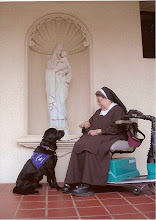Icon of Our Lady of Mt. Carmel
The Icon has been called “A window into heaven”. Every detail has meaning and conveys a message in the language of symbolism. One “reads” this message by pondering it in their heart, as Mary did with the mysteries of Jesus. [Lk. 2: 19]
In the center we see the figure of Our Lady, standing within a Mandorla. She seems to be coming forth from a deep indigo background, the same color as we see in the caves within the mountain below. This color signifies the mystical depths of the divine, drawing us inward to union with God. [Ps. 42: 7,8] The Mandorla is an ancient symbol of two circles coming together, overlapping one another to form an almond shape in the middle. It is used as a method to describe the coming together of heaven and earth, between the divine and human, and between all opposites. It is in this space that all transformation takes place.
Mary is showing us her Divine Son. She is not holding him in her arms, but he shines forth from within her heart where he reigns: they are inseparable. Both Jesus and Mary are looking directly at the viewer. Our Lady is offering the scapular of Carmel, the “garment of salvation” worn by all Carmelites. On either side and above the Virgin are flaming seraphim -- God’s highest servants, who minister to Him and proclaim His glory, each calling to the other: “Holy, holy, holy, Lord God of hosts...” [Isa. 6:2] -- the prototype of Carmel’s ceaseless prayer.
The radiant gold background represents the divine Light of the celestial universe, penetrating and illuminating our earthly lives. In the upper corners we see the sun and the moon, each lighting our days and our nights. Lettters in white shining out of the gold read: “Regina Decor Carmeli”, or “Queen Beauty of Carmel”. The Greek letters on either side of Our Lady’s head are the abbreviated form of “Maria Theotokos” -- Mary Mother of God. The letters within the blue nimbus surrounding the divine Child say, “Jesus” and “Christ”
The lower part of the icon shows the rocky promontory of Mt. Carmel jutting out into the blue waters of the Mediterranean Sea from which Elijah saw, in prophetic vision, the little cloud -- a symbol of the Virgin Mary -- that presaged the end of a long drought. [1 Kgs. 18:42-46] In the heart of the mountain we see the Prophet Elijah to the right, holding a scroll in his hand, signifying his great epiphany on the mountain of God [1 Kgs. 19: 4-14], and St. Joseph opposite him, holding his staff, signifying his faithful journey, as he walked in the way of the Lord. [Mt. 2: 20-23]
Between the two patriarchs a tree is rising out of the thirsty ground. It calls to mind the central precept given to all Carmelites in the Primitive Rule to meditate day and night on the law of the Lord. [cf. Ps. 1: 2,3] “The law of the Lord is their joy; God’s law they study day and night. They are like a tree planted near streams of water....” It is the Tree of LIfe, the Flower of Carmel, the Cedar of Lebanon. [Ps. 92: 13-16]
Ascending the mountain on either side are St. Teresa and St. John of the Cross as they show us the way. All eyes are lifted up to the Virgin and her divine Son.
This beautiful icon is a treasured possession of the Carmelite Nuns in San Diego.
The original hangs in the monastery chapter room.


No comments:
Post a Comment